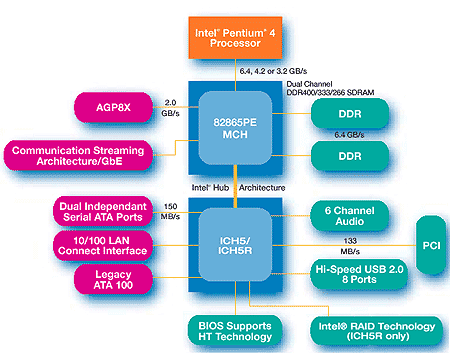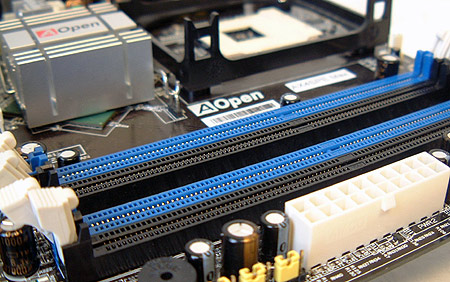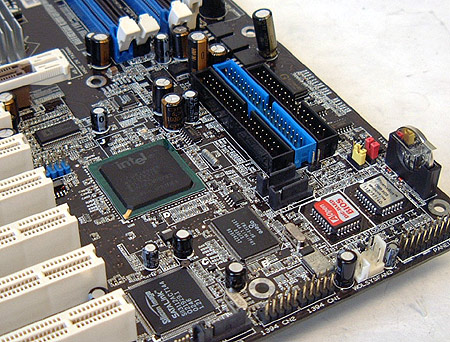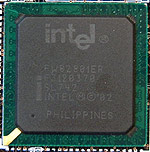
|
The release of the Intel i865 'Springdale' chipset comes today, and Intel has released
no fewer than three flavours (i865P/G/PE) to choose from.
82% Rating: 
|
|
|
|
Home >
Reviews >
Motherboards >
AOpen AX4SPE Max |
|
|
Meet the i865PE and CSA, ICH5R
While the AOpen AX4SPE Max is the only i865PE motherboard we
have tested to date, we were a bit surprised to read in Intel's documentation,
and in the user manual that the board will not
support 'Williamette' or Celeron processors Socket
478 processors. This
may be more of a limitation of the i865PE chipset though rather then a problem
with the motherboard however.
|
The Broadcom BCM5702CKFB controller is a fully integrated
32-bit 10/100/1000BASE-T Gigabit Ethernet Media Access
Control and Physical Layer Transceiver solution.
The BCM5702 combines PCI bus interfaces,
on-chip buffer memory, and integrated physical layer transceiver (PHY) in
a single device. Based on a low-voltage 0.13um CMOS process , the
single BGA chipset is reportedly fine for use in zero-airflow
environments.
The BCM5702 supports with full/half-duplex
capability at all speeds, and includes an on-chip power circuit
controller, WOL, and CPU task off load capability. Windows 98/NT/2000/XP
and Linux 2.2/2.4 are the supported
OS's. |

The i865PE Springdale Chipset:
The
i865PE
is Intel's new mainstream chipset, and it offers support for 400 MHz, 533
MHz and 800 MHz FSB Northwood Pentium 4's. The little flip chip also brings
a whole slew of new features to the mainstream Pentium 4 users, most
notably of which are 8X AGP, Dual Channel DDR and CSA (more on CSA below).
By now, most of you should be familiar with
8x AGP, and know that it provides the videocard with up to 2.1 GB/s
worth of bandwidth which doubles the amount of data that can be sent back
and forth. While real world performance has not received any significant gains
due to 8x AGP, it has potential, and may be important in the future when games
rely more heavily on the AGP bus.
Looking back for a moment it is clear that
the fatal flaw of the i845 DDR chipsets were that they could never provide enough memory bandwidth to
keep the Pentium 4 happily fed. This was because they only possed a single DDR memory
channel.

Even the latest i845PE
introduced could only provide a 400 MHz FSB based Pentium 4 processors 2.1 GB/s
of bandwidth and, 533 MHz FSB based P4's 2.7GB/s of bandwidth. A far cry from the 3.2 GB/s
bandwidth required for the 400 MHz processors and 4.2 GB/s for the 533 MHz FSB
chips.
With the i865PE, there are now two memory
channels working in parallel to double the bandwidth available to the processor. For instance, a
533 MHz FSB based Pentium 4 needs 4.2 GB/s of bandwidth to be "happy."
If we were to run two PC2100 DIMM's in parallel they offer exactly 4.2 GB/s (memory
channel 1 2.1 GB/s + memory channel 2 2.1 GB/s) of bandwidth when running at 133
MHz FSB. An 800 MHz FSB based Pentium 4 requires 6.4 GB/s so running dual
channel DDR 400 memory will provide that required 6.4 GB/s.
Everyone who read that without eyes glossing over stand up, raise your arms and
yell out "The Pentium 4 is no longer bandwidth starved, the i865PE has saved
the day!" There, now you are officially a techno-geek! :-)

Enter CSA, yay more
acronyms...
Gigabit
Ethernet
is nothing new to the world of computers and while some of
the motherboards we have tested at PCstats.com in the past had this option, one
of the potential problems that may arise is when a Gigabit connection is
running at full speed (full duplex, 2Gb/s or 250MB/s). At those speeds it has the
potential to saturate the PCI bus and leave little or nothing for the other
devices. What a perfect place to introduce the new CSA
bus!
CSA stands for Communications
Streaming Architecture and what it does is give the Gigabit Ethernet controller a
direct 16 bit link to the MCH (Memory Controller Hub). The maximum bandwidth
available on the CSA is 266 MB/s, just a tad more then the maximum 250 MB/s (Full
Duplex) can produce.
Intel
being Intel, the company naturally
has a patent over CSA technology and may license this out. It's up to chip
manufacturers to see if they want to pay the extra fee for a CSA NIC. The
AOpen
AX4SPE MAX uses a Broadcom 10/100/1000 NIC which does
not
run through CSA, rather it goes through
the PCI bus.
ICH5/R Southbridge:
 One
of the most significant features Intel have implemented on the new ICH5 southbridge is native Serial ATA
support. One
of the most significant features Intel have implemented on the new ICH5 southbridge is native Serial ATA
support.
Now that two Serial ATA headers are integrated into the
ICH5 southbridge yet another bottleneck is removed. The theoretical maximum bandwidth of Serial ATA
currently is 150MB/s, and as you can see this is more than the 133MB/s
the PCI bus offers (yes I know that current drives will not reach that
speed).
If one
were to run Gigabit LAN, Serial ATA HDD's and say... some other high bandwidth
devices like an external IEEE 1394 HDD, the PCI bus could be saturated very
quickly.
The ICH5 supports two Serial ATA channels as well as two
parallel IDE channels for a total of six possible drives (one drive per SATA
channel). The ICH5 also increases the number of USB2.0 ports from four to eight.
As you probably noticed, we said the AOpen AX4SPE
Max uses the ICH5R southbridge,
and the 'R' stands for RAID.
Initially, the ICH5R only supported RAID 0 (stripping), but Intel is working on
including RAID 1 as well and all that is required is for the end user to flash
their motherboard with a newer BIOS.
Normally
if you want to make any changes to a RAID setup, it requires you to format and
reinstall your software. Intel has made life a bit easier for the end user so
that if you get a second HDD of the same size and would like to take
advantage of the RAID 0 setup, simply use the Intel Application
Accelerator software to set RAID 0 on both your drives! Please keep in
mind, this is for Serial ATA only. Up next, PCstats.com takes a look inside the AX4SPE Max BIOS...
|
